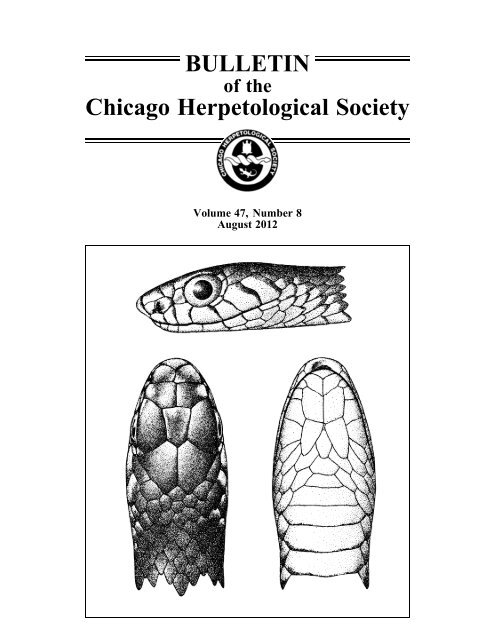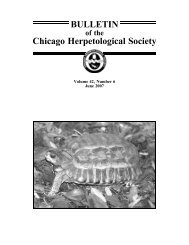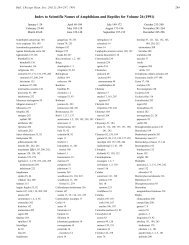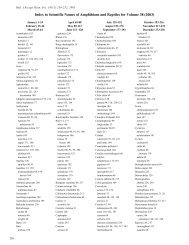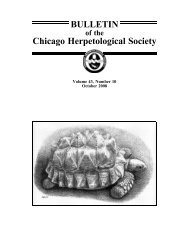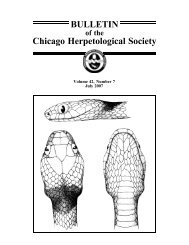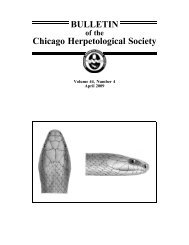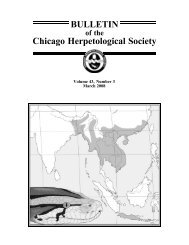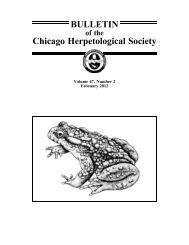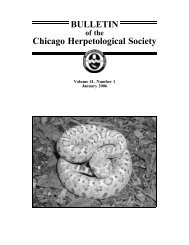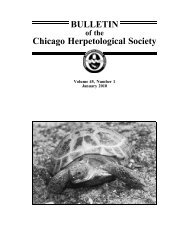August - Chicago Herpetological Society
August - Chicago Herpetological Society
August - Chicago Herpetological Society
Create successful ePaper yourself
Turn your PDF publications into a flip-book with our unique Google optimized e-Paper software.
BULLETIN<br />
of the<br />
<strong>Chicago</strong> <strong>Herpetological</strong> <strong>Society</strong><br />
Volume 47, Number 8<br />
<strong>August</strong> 2012
BULLETIN OF THE CHICAGO HERPETOLOGICAL SOCIETY<br />
Volume 47, Number 8<br />
<strong>August</strong> 2012<br />
A Note on the Diet of Common Garter Snakes, Thamnophis sirtalis, in Pennsylvania .................... Brian S. Gray 97<br />
Book Review: The Amphibians and Reptiles of Michigan: A Quaternary and Recent Faunal Adventure by J. Alan Holman . . . . . .<br />
.................................................................... John G. Palis 99<br />
What You Missed at the July Meeting ............................................... John Archer 102<br />
Herpetology 2012.................................................................. 106<br />
Unofficial Minutes of the CHS Board Meeting, July 13, 2012 . . . . . . . . . . . . . . . . . . . . . . . . . . . . . . . . . . . . . . . . . 107<br />
Advertisements ................................................................... 108<br />
Cover: Gold’s tree cobra, Pseudohaje goldii. Drawing from Genera des Serpents du Congo et du Ruanda-Urundi by Gaston-François de Witte,<br />
Musee Royal de l’Afrique Centrale — Tervuren, Belgium. Annales — Serie in 8º — Sciences Zoologiques —No. 104, 1962.<br />
STAFF<br />
Editor: Michael A. Dloogatch --- madadder0@aol.com<br />
Advertising Manager: Ralph Shepstone<br />
2012 CHS Board of Directors<br />
Jason Hood, President<br />
Cindy Rampacek, Vice-President<br />
Andy Malawy, Treasurer<br />
Jenny Vollman, Recording Secretary<br />
Deb Krohn, Corresponding Secretary<br />
Aaron LaForge, Publications Secretary<br />
Mike Dloogatch, Membership Secretary<br />
Jim Foster, Sergeant-at-arms<br />
Lawrence Huddleston, Member-at-large<br />
Barbara Khan, Member-at-large<br />
Nancy Kloskowski, Member-at-large<br />
Linda Malawy, Member-at-large<br />
The <strong>Chicago</strong> <strong>Herpetological</strong> <strong>Society</strong> is a nonprofit organization<br />
incorporated under the laws of the state of Illinois. Its<br />
purposes are education, conservation and the advancement<br />
of herpetology. Meetings are announced in this publication,<br />
and are normally held at 7:30 P.M., the last Wednesday of<br />
each month.<br />
Membership in the CHS includes a subscription to the monthly<br />
Bulletin. Annual dues are: Individual Membership, $25.00;<br />
Family Membership, $28.00; Sustaining Membership, $50.00;<br />
Contributing Membership, $100.00; Institutional Membership,<br />
$38.00. Remittance must be made in U.S. funds. Subscribers<br />
outside the U.S. must add $12.00 for postage. Send membership<br />
dues or address changes to: <strong>Chicago</strong> <strong>Herpetological</strong> <strong>Society</strong>,<br />
Membership Secretary, 2430 N. Cannon Drive, <strong>Chicago</strong>, IL 60614.<br />
Manuscripts published in the Bulletin of the <strong>Chicago</strong> <strong>Herpetological</strong><br />
<strong>Society</strong> are not peer reviewed. Manuscripts should be<br />
submitted, if possible, by email or on IBM PC-compatible or<br />
Macintosh format diskettes. Alternatively, double-spaced, typewritten<br />
manuscripts may be submitted in duplicate. Manuscripts<br />
and letters concerning editorial business should be sent to: <strong>Chicago</strong><br />
<strong>Herpetological</strong> <strong>Society</strong>, Publications Secretary, 2430 N. Cannon<br />
Drive, <strong>Chicago</strong>, IL 60614. Back issues are limited but are available<br />
from the Publications Secretary for $2.50 per issue postpaid.<br />
Visit the CHS home page at .<br />
The Bulletin of the <strong>Chicago</strong> <strong>Herpetological</strong> <strong>Society</strong> (ISSN<br />
0009-3564) is published monthly by the <strong>Chicago</strong> <strong>Herpetological</strong><br />
<strong>Society</strong>, 2430 N. Cannon Drive, <strong>Chicago</strong> IL 60614.<br />
Periodicals postage paid at <strong>Chicago</strong> IL. Postmaster: Send<br />
address changes to: <strong>Chicago</strong> <strong>Herpetological</strong> <strong>Society</strong>, Membership<br />
Secretary, 2430 N. Cannon Drive, <strong>Chicago</strong> IL 60614.<br />
Copyright © 2012
Bull. <strong>Chicago</strong> Herp. Soc. 47(8):97-98, 2012<br />
A Note on the Diet of Common Garter Snakes, Thamnophis sirtalis, in Pennsylvania<br />
Brian S. Gray<br />
Natural History Museum at the Tom Ridge Environmental Center<br />
301 Peninsula Drive<br />
Erie, PA 16506<br />
brachystoma@hotmail.com<br />
Common garter snakes, Thamnophis sirtalis, are generalized<br />
predators that include a wide variety of prey in their diet. In<br />
Pennsylvania, prey items include earthworms, anurans, salamanders,<br />
birds and small mammals (Surface, 1906; Hulse et al.,<br />
2001). In addition to live prey, carrion in the form of dead<br />
amphibians or birds (Figure 1) may also be consumed (Gray,<br />
2002). Salamander species listed as being consumed by Pennsylvania<br />
T. sirtalis include northern redback salamanders, Plethodon<br />
cinereus, and northern slimy salamanders, P. glutinosus<br />
(Surface, 1906). Herein, I report an ambystomid salamander in<br />
the diet of a T. sirtalis from Erie County, Pennsylvania.<br />
On 2 July 2012, ca. 1940 h, at a site just north of the Conrail<br />
tracks along the Highway 832 bridge in Erie County, Pennsylvania,<br />
I found a male T. sirtalis (380 mm SVL, 500 mm total<br />
length, 36 g. mass) under a large piece of corrugated cardboard.<br />
The snake was coiled and had a surface temperature of 23.4C;<br />
air temperature was 27.0C. The surface temperature of the<br />
snake was obtained with a noncontact infrared thermometer<br />
Figure 2. Partially digested spotted salamander, Ambystoma maculatum,<br />
disgorged by a common garter snake, Thamnophis sirtalis, from Erie,<br />
Pennsylvania, that was found 2 July 2012.<br />
(Raytec MiniTemp MT 6). The snake had an obvious bulge at<br />
midbody suggesting a recent meal. Upon handling the snake, it<br />
disgorged a partially digested spotted salamander, Ambystoma<br />
maculatum (118.7 mm total length, 11 g mass) (Figure 2). The<br />
ratio of prey mass to snake mass was 0.31.<br />
Based on the orientation of the salamander when disgorged<br />
(head first), it must have been consumed tail end first. On the<br />
dorsal surface of the body and tail of A. maculatum are numerous<br />
granular glands that produce noxious alkaloid secretions<br />
(Figure 3) that reportedly repulse attacks by some mammals,<br />
birds and reptiles (Petranka, 1998; Vitt and Caldwell, 2009).<br />
The secretions of these glands are described as neurotoxic (Vitt<br />
and Caldwell, 2009). Minton (2001), upon touching some to his<br />
tongue, experienced an astringent taste followed by tingling and<br />
numbness. Apparently, T. sirtalis is not thwarted by these secretions.<br />
Common garter snakes are also known to prey on Ameri-<br />
Figure 1. A common garter snake, Thamnophis sirtalis, from Erie,<br />
Pennsylvania, found 28 July 1998. The snake disgorged the bird limbs<br />
upon being handled. It was determined that the bird limbs were<br />
previously consumed as carrion.<br />
Figure 3. Dorsal skin secretions on the tail of a spotted salamander,<br />
Ambystoma maculatum.<br />
97
can toads, Anaxyrus americanus, which also produce toxic skin<br />
secretions as a defensive measure. Incidentally, the author once<br />
had a captive male T. sirtalis that consumed a red eft, Notophthalmus<br />
viridescens, without any noticeable ill effects. The<br />
skin of the red eft contains tetrodotoxin which can be lethal if<br />
ingested (Minton, 2001).<br />
At the time of the above observation the slope along the<br />
bridge was very dry and a significant portion of the flora (e.g.<br />
crown vetch, Coronilla varia, and goldenrod, Solidago sp.) was<br />
beginning to wilt. As of 2 July 2012 the region had only received<br />
15.10 inches of precipitation, 3.84 inches below the<br />
normal average seasonal accumulation of 18.94 in. Even in<br />
adjacent swamp forest the substrate was dry in most places.<br />
Therefore, it is unlikely that the spotted salamander was consumed<br />
while moving about on the surface. Rather, it was likely<br />
consumed in a retreat under some sort of cover object. A.<br />
maculatum were last observed by the author on the slope of the<br />
bridge 1 May 2012.<br />
Although T. sirtalis has been reported to consume A. maculatum<br />
(Ernst and Ernst, 2003), I believe this to be the first record<br />
of a Pennsylvania specimen doing so.<br />
Literature Cited<br />
Ernst, C. H. and E. M. Ernst. 2003. Snakes of the United States and Canada. Washington, D.C.: Smithsonian Books.<br />
Gray, B. S. 2002. Thamnophis sirtalis sirtalis (Eastern Garter Snake). Diet. <strong>Herpetological</strong> Review 33(2):142-143.<br />
Hulse, A. C., C. J. McCoy and E. J. Censky. 2001. Amphibians and reptiles of Pennsylvania and the Northeast. Ithaca, New York: Cornell<br />
University Press.<br />
Minton, S. A., Jr. 2001. Amphibians and reptiles of Indiana. Second edition. Indianapolis, Indiana: Indiana Academy of Science.<br />
Petranka, J. W. 1998. Salamanders of the United States and Canada. Washington, D.C.: Smithsonian Institution Press.<br />
Surface, H. A. 1906. The serpents of Pennsylvania. Bull. Pennsylvania St. Dept. Agric. Div. Zool. 4:113-208.<br />
Vitt, L. J., and J. P. Caldwell. 2009. Herpetology: An introductory biology of amphibians and reptiles. Third edition. Burlington,<br />
Massachusetts: Elsevier, Academic Press.<br />
98
Bull. <strong>Chicago</strong> Herp. Soc. 47(8):99-101, 2012<br />
Book Review: The Amphibians and Reptiles of Michigan: A Quaternary and Recent Faunal Adventure<br />
by J. Alan Holman. 2012. 312 pp., 165 illustrations. Wayne State University Press, Detroit, Michigan.<br />
ISBN 978-0-8143-3239-9. Hardcover. $50.00<br />
John G. Palis<br />
Palis Environmental Consulting<br />
P.O. Box 387<br />
Jonesboro, IL 62952<br />
jpalis@yahoo.com<br />
A comprehensive statewide<br />
treatment of Michigan’s entire<br />
herpetofauna had not been attempted<br />
since the early 1900s<br />
(Ruthven et al., 1912; 1928).<br />
Wayne State University Press<br />
resolved this situation by publishing<br />
J. Alan Holman’s Amphibians<br />
and Reptiles of Michigan<br />
in May 2012. This welcome<br />
update to the outdated<br />
work of Ruthven and colleagues<br />
almost did not happen.<br />
A Publisher’s Note preceding the Table of Contents informs the<br />
reader that Holman “died suddenly just days after turning in his<br />
manuscript to the press.” Holman died of a heart attack on 12<br />
<strong>August</strong> 2006 after a long and productive career, principally as a<br />
paleoherpetologist (Harding, 2006). Fortunately for students of<br />
Michigan and midwestern herpetology, Holman’s friends and colleagues<br />
--- James Harding, James Gillingham and David Mifsud ---<br />
saw the manuscript through publication. These gentlemen are to<br />
be commended for generously sharing their time and expertise<br />
with the Press.<br />
This attractive (a stylized image of a spotted salamander<br />
graces the front cover) and well-constructed book is divided into<br />
three main parts: 1) Introduction, 2) Species Accounts, and --- a<br />
unique feature of this book --- 3) a summary of the Michigan<br />
herpetological fauna in Quaternary and recent historical times.<br />
These sections are followed by references cited (by my count,<br />
nine citations are CHS Bulletin articles), a general index, a taxonomic<br />
index, and a site index of fossil and archaeological sites.<br />
In the Introduction, Holman describes Michigan in a manner<br />
that never occurred to me, as “two large peninsulas that penetrate<br />
large inland freshwater seas” (Michigan borders four of the<br />
five Great Lakes). He introduces the reader to Michigan geological<br />
history and points out that today’s herpetofauna recolonized<br />
following the retreat of the last glacier, which covered the entire<br />
state in mile-high ice for thousands of years. He goes on to<br />
describe landscape changes wrought by Euro-Americans and<br />
introduces Michigan’s four regional landscape ecosystems.<br />
Holman follows with descriptions of “modern herpetological<br />
habitats,” including terrestrial and aquatic natural communities<br />
as well as urban settings. In the latter section, Holman describes<br />
the reduction in herpetofaunal diversity in his own backyard<br />
between 1967 and 1977, and suggests a similarly diminished<br />
herpetofauna now occurs across the eastern third of the United<br />
States. A chronological “who’s who” in Michigan herpetological<br />
history follows, as does a discussion of amphibian and<br />
reptile collection procedures and identification. A unique feature<br />
of the identification section is Holman’s treatise on identifying<br />
amphibian and reptile bones and bone fragments. For up-to-date<br />
collection and possession regulations, Holman directs the reader<br />
to the Michigan Fishing Guide published annually by the Michigan<br />
Department of Natural Resources.<br />
Figure 1 in the Introduction is a small (about one-third of the<br />
left-hand column of one page) map of Michigan depicting each<br />
county and three large islands. The typeface used for the county<br />
names is tiny, and the letters are so crowded together that the<br />
names are impossible to read, even when examined with a 10×<br />
hand lens. This is particularly unfortunate as Holman often<br />
refers to particular counties throughout the book. Fortunately for<br />
the reader, another small map of Michigan showing county<br />
names (and the four regional landscape ecosystems) appears<br />
eight pages later in the Introduction. County names on that map<br />
are more legible; however, given their small size I believe the<br />
reader would be well served to slip into the book a larger map of<br />
Michigan on which the county names are more readable.<br />
Species accounts comprise the bulk of the book. Here,<br />
Holman provides detailed information for all 54 of Michigan’s<br />
amphibians and reptiles. Each account includes a color photograph,<br />
a small Michigan range map, and topic headings that<br />
include identification (I like the inclusion of both metric and<br />
English measurements), general and Michigan distribution,<br />
geographic variation, habits and habitats, reproduction and<br />
growth (frog calls are described here or in the identification<br />
section), diet, predation and defense, interaction with humans,<br />
behavioral characteristics, population health, and general remarks.<br />
Several amphibian accounts also include drawings from<br />
Clifford H. Pope’s (1944) classic, Amphibians and Reptiles of<br />
the <strong>Chicago</strong> Area.<br />
At the beginning of the Species Accounts section, Holman<br />
shares the sources he uses for taxonomic arrangements. For<br />
scientific names (i.e., genus, species, subspecies), for example,<br />
he generally follows Crother (2008). However, he notes that<br />
“taxonomic placement and scientific names of amphibians and<br />
reptiles are presently quite unstable” and that “new arrangements<br />
of relationships are proposed on an almost daily basis.”<br />
So, in cases where recent proposed changes “remain controversial,”<br />
Holman retains “more familiar and traditional nomenclature.”<br />
For example, instead of following Frost et al. (2006) and<br />
using Anaxyrus for toads, and Lithobates for true frogs, he uses<br />
the familiar generic designations Bufo and Rana. I greatly appreciate<br />
his cautious approach to these recent taxonomic changes<br />
(see Holman, 2006).<br />
The book lacks a dichotomous key and Holman (in the<br />
99
Introduction) directs the reader to identify amphibians and<br />
reptiles by looking “at the pictures until you find the species that<br />
most closely matches your specimen.” Each species is depicted<br />
by a single color photograph. Given the relatively depauperate<br />
herpetofauna of Michigan, examination of the photographs<br />
alone will generally serve to identify most species. For some<br />
groups or species, however, additional photographs or drawings<br />
would have greatly enhanced the reader’s ability to identify<br />
Michigan’s amphibians and reptiles. For example, the inclusion<br />
of larval amphibian images would have provided the reader with<br />
a resource for identifying the life stage that, for some species<br />
(e.g., mole salamanders), is more likely to be encountered than<br />
the adult stage. Holman does provide written descriptions of<br />
amphibian larvae, but nothing replaces a good photograph.<br />
Photographs of juvenile snakes that differ markedly from adults<br />
(e.g., blue racer, central ratsnake) would also have made the<br />
book more useful to the novice herpetophile. A few salamander<br />
photographs (four-toed salamander, in particular) are dark and<br />
may make identification by photograph a challenge. In some<br />
cases (e.g., common watersnake), the image is of an animal that<br />
is too distant to see it clearly. In general, however, the photographs<br />
are high-quality and sufficient for identification.<br />
I noticed a few omissions/errors in the identification sections<br />
of species accounts that could have been addressed with more<br />
careful pre-publication editing. In relatively few accounts, for<br />
example, does Holman discuss how to distinguish males from<br />
females. In some snake accounts, certain identifying characters<br />
such as whether scales are keeled or smooth (e.g., blue racer,<br />
northern ribbonsnake) or whether the anal plate is divided or not<br />
(e.g., blue racer, common watersnake, northern ribbonsnake,<br />
eastern massasauga) are not mentioned. In at least one account<br />
(smooth greensnake), he refers (once) to the species by the<br />
wrong vernacular name (“common” greensnake). In the eastern<br />
American toad account, the word “species” is used mistakenly in<br />
place of “specimens.” Fortunately for the reader, such omissions/errors<br />
seem to be rare.<br />
Each species account includes a small map of Michigan with<br />
a single dot placed centrally in each county in which the species<br />
occurs. Holman purposely chose to be rather vague about plotting<br />
occurrences because he had evidence that Michigan’s<br />
herpetofauna has “been targeted by illegal collectors.” He was<br />
concerned that dots indicating exact collection localities could<br />
be used by collectors “to find local herpetological ‘hot spots.’”<br />
The inclusion of a small eastern North America map showing<br />
the entire range of each species would have provided the reader<br />
with a sense of how Michigan relates to each species’ geographic<br />
range.<br />
In regards to the distribution of boreal and western chorus<br />
frogs in Michigan, readers may wish to keep abreast of the work<br />
of Emily Moriarty Lemmon at Florida State University. Holman’s<br />
maps and discussion of the Michigan distribution of<br />
boreal chorus frogs indicates they are limited to Isle Royale; he<br />
plots western chorus frogs across the remainder of the state,<br />
including both the Upper and Lower peninsulas. The map in<br />
Lemmon et al. (2007), however, suggests that boreal chorus<br />
frogs range across the entire Upper Peninsula and that western<br />
chorus frogs occur only in the Lower Peninsula. Unfortunately,<br />
Lemmon et al. (2007) did not have material from the Upper<br />
Peninsula when conducting their study, so Michigan herpetophiles<br />
will have to await an update of their work.<br />
The species accounts are rich with information (including<br />
observations made outside of Michigan), and credited to various<br />
sources as well as Holman’s direct observations. Holman seems<br />
to rely heavily on Minton (2001) and Harding (1997) and quotes<br />
text from both tomes frequently. Rather than provide a glossary,<br />
Holman chose to “write with as little scientific jargon as possible.”<br />
When scientific jargon is unavoidable, Holman provides a<br />
definition of the word the first time it appears in the book. This<br />
could prove problematic for the reader who skips around the<br />
book to read about particular species of interest rather than<br />
reading the book cover to cover. For example, a novice herper<br />
who encounters an eastern tiger salamander and reads Holman’s<br />
account to learn more about the species will encounter the word<br />
“spermatophore.” Without a glossary of scientific terms to refer<br />
to, the reader may be left wondering about the identity of a<br />
spermatophore. Spermatophore is defined once, in the bluespotted<br />
salamander account. There are similar examples for<br />
other terms (e.g., keeled scales and anal plate defined only in the<br />
first snake account --- Kirtland’s snake). Thus, unless one reads<br />
the book from beginning to end, definitions of scientific terms<br />
may not be encountered. I did discover two entries in the General<br />
Index (“bogs” and “sibling species”) that were followed by<br />
a comma and the word, “defined.” It would have been helpful to<br />
the reader if other terms defined in the text were included in the<br />
General Index.<br />
In many places Holman expresses genuine concern about the<br />
future of Michigan’s herpetofauna. For example, in the Preface,<br />
Holman states that Michigan’s herpetologists “fidget and fret<br />
about the diminishing populations of amphibians and reptiles in<br />
the state . . . not only . . . the officially threatened and endangered<br />
species of concern but also the many species that were very<br />
common throughout large portions of the state as recently as the<br />
early 1980s.” Some causes of these declines are mentioned in<br />
various species accounts and include habitat loss and fragmentation,<br />
global warming, human persecution, road mortality, introduction<br />
of predators, invasive plants, use of chemicals to control<br />
aquatic snails and lampreys, and run-off of herbicides, insecticides,<br />
and road salt into water bodies. Holman does not waver when he<br />
describes as “reprehensible” humans who “dogmatically kill any<br />
snakes they find” or shoot basking turtles for target practice (a<br />
practice known as “plinking”). I share Holman’s disgust with<br />
these people who, as he says, “waste wildlife resources.”<br />
Holman freely shares other opinions throughout the species<br />
accounts; a few examples of which follow. Of red-eared<br />
sliders --- which now range across much of the planet due to<br />
human introduction --- Holman poetically states they have “survived<br />
the dingy pet shops and swirling toilet bowls to conquer<br />
the turtle world.” Holman “detests” the alternate moniker for<br />
eastern musk turtle (i.e., “stinkpot”). I’ve always liked “stinkpot”<br />
and cannot understand why Holman finds it so offensive. In<br />
at least two cases, Holman advises the reader on how to become<br />
a “herpetological hero” in Michigan: by finding 1) an extant<br />
population of western lesser sirens or 2) a new population of<br />
copper-bellied watersnakes. In expressing his dislike for collect-<br />
100
ing and preserving amphibians for dissection in classrooms<br />
Holman writes, “a mudpuppy is a typical amphibian only by a<br />
long stretch of the imagination” and “to say that a frog is a<br />
typical vertebrate is ludicrous.” On a lighter note, he describes<br />
toad watching as “great fun.”<br />
What I enjoy even more than his opinions are the brief anecdotal<br />
stories (“whimsical accounts”) Holman shares. In the<br />
eastern tiger salamander account, for example, Holman remembers<br />
finding a “huge, somewhat fidgety pile” of these salamanders<br />
(estimated to be at least 250 recently-metamorphosed<br />
individuals) in the dark corner of a basement while in search of<br />
an errant ping-pong ball. My favorite anecdote, however, is<br />
Holman’s story of being bitten by an eastern snapping turtle. It<br />
occurred “years ago” while Holman was fishing near Memphis,<br />
Tennessee, “sitting happily on top of a galvanized minnow<br />
bucket hoping to catch a catfish.” As he describes it, he felt “a<br />
sharp pain in my rear and discovered an eight-inch snapper<br />
hanging on my blue jeans.” The snapper released its grip when<br />
Holman stood up. The turtle walked to the water “amidst a hail<br />
of four-letters words” that Holman says he “acquired in the<br />
Navy.” This is one of those improbable stories that had it been<br />
relayed to me by a typical fisherman I would have considered a<br />
tall tale; but, because it came from someone with Holman’s<br />
credentials, I can accept it without hesitation and contemplate<br />
the turtle’s peculiar behavior.<br />
Holman also shares interesting factoids and dispels myths.<br />
For example, we learn that eastern American toads living on<br />
Michigan’s islands are larger than their counterparts on the<br />
mainland and that this phenomenon is typical of island-inhabiting<br />
populations in many species. Holman assures the reader that<br />
neither toad urine nor handling of toads will “form warts on<br />
humans.” Holman also expresses his wonderment with nature:<br />
describing as “a truly amazing turnabout” the aquatic adult<br />
eastern newt returning to the terrestrial form when its pond<br />
dries. It is refreshing to see a well-respected professional herpetologist<br />
unafraid to acknowledge his wonderment with his<br />
subject. I also discovered that Holman and I are kindred spirits,<br />
each of us moving amphibians and reptiles off the road and out<br />
of harm’s way whenever it is safe to do so.<br />
The third principal section of the book is entitled, “Quaternary<br />
Remains of Michigan Amphibians and Reptiles.” This<br />
section is unique among state herpetofauna guides and provides<br />
detailed accounts of the amphibians and reptiles known to<br />
inhabit Michigan in the Pleistocene and Holocene, as well as<br />
those discovered at Michigan archaeological sites. Here the<br />
reader learns that cooked turtle bones have a “characteristic blue<br />
or white color” and that turtle shells --- particularly those of<br />
Blanding’s turtles --- were favored by Native Americans for use<br />
as bowls. Holman describes the fossil-hunting process and the<br />
uninitiated (like me) gains an appreciation for the saint-like<br />
patience required of paleoherpetologists. As a neoherpetologist,<br />
however, who enjoys interacting with living animals, I found<br />
this part of the book rather tedious until, that is, I came to Holman’s<br />
discussion of biogeography. Here the reader learns that<br />
Michigan’s herpetofaunal diversity is greatest in the southern<br />
half of the Lower Peninsula and lowest in the Upper Peninsula;<br />
a result of warmer temperatures (over time) and greater habitat<br />
diversity in the Lower Peninsula. Holman ends this section with<br />
a discussion of the herpetofauna of Lake Michigan islands.<br />
After reading Holman’s opus, I regret never having made his<br />
acquaintance. I feel I could have learned a great deal from this<br />
man who knew so much about both contemporary herpetology<br />
and paleoherpetology. I thoroughly enjoyed his book and highly<br />
recommend it to anyone interested in Michigan or Midwestern<br />
herpetology. I consider it a welcome addition to my bookshelf<br />
and will have it in hand on my next trip to Michigan.<br />
Acknowledgment<br />
I thank Mike Dloogatch for entrusting me with the enjoyable<br />
task of reviewing Holman’s book and for his editorial suggestions.<br />
Literature Cited<br />
Crother, B. I. 2008. Scientific and standard English names of amphibians and reptiles of North America north of Mexico. 6th edition.<br />
SSAR <strong>Herpetological</strong> Circular 37.<br />
Frost, D. R., T. Grant, J. Faivovich, R. H. Bain, A. Haas, C. F. B. Haddad, R. O. De Sa, A. Channing, M. Wilkinson, S. C. Donnellan, C. J.<br />
Raxworthy, J. A. Campbell, B. L. Blotto, P. Moler, R. C. Drewes, R. A. Nussbaum, J. D. Lynch, D. M. Green and W. C. Wheeler. 2006.<br />
The amphibian tree of life. Bulletin of the American Museum of Natural History 297.<br />
Harding, J. H. 1997. Amphibians and reptiles of the Great Lakes Region. Ann Arbor: University of Michigan Press.<br />
)))))))). 2006. Obituary: J. Alan Holman (1931–2006). <strong>Herpetological</strong> Review 37(4):398-399.<br />
Holman, J. A. 2006. A short note on the appearance of The Amphibian Tree of Life by Darrel R. Frost and eighteen other authors. Bull.<br />
<strong>Chicago</strong> Herp. Soc. 41(4):78.<br />
Lemmon, E. M., A. R. Lemmon, J. T. Collins, J. A. Lee-Yaw and D. C. Cannatella. 2007. Phylogeny-based delimitation of species<br />
boundaries and contact zones in the trilling chorus frogs (Pseudacris). Molecular Phylogenetics and Evolution 44(3):1068-1082.<br />
Minton, S. A. Jr. 2001. Amphibians and reptiles of Indiana. 2nd edition. Indiana Academy of Science, Indianapolis.<br />
Pope, C. H. 1944. Amphibians and reptiles of the <strong>Chicago</strong> area. <strong>Chicago</strong>, Illinois: <strong>Chicago</strong> Natural History Museum Press.<br />
Ruthven, A. G., C. Thompson and H. Thompson. 1912. The herpetology of Michigan. Michigan Geological and Biological Survey 10.<br />
Ruthven, A. G., C. Thompson and H. Gaige. 1928. The herpetology of Michigan. University of Michigan Handbook Series No. 3.<br />
101
Bull. <strong>Chicago</strong> Herp. Soc. 47(8):102-105, 2012<br />
What You Missed at the July Meeting<br />
John Archer<br />
j-archer@sbcglobal.net<br />
I suppose that getting a call at the last minute to fill in for a<br />
speaker who had to cancel might feel a little like being a backup<br />
date, but our July speaker was anything but a second choice.<br />
Bryan Suson has been a presenter before at our meetings and<br />
will surely be a speaker again, but this time he was nice enough<br />
to fill in at the last minute. He’s local, takes great photographs,<br />
is enthusiastic, and holds the interest of the audience with no<br />
trouble. To have a speaker such as he come in as a substitute is a<br />
coup for the CHS.<br />
I’ve been lucky enough to have known Bryan for quite<br />
awhile but I googled him anyway and found perhaps the best<br />
description of him on the website of an environmental consulting<br />
company for which he occasionally works. Under the “Team”<br />
descriptions Bryan is listed as a biologist with “expertise” in<br />
“tropical ecology, birds, reptiles, amphibians, insects, field crew<br />
leader, and wildlife photography.” Seems to sum it up, but that<br />
description is a little incomplete. It fails to describe how Bryan’s<br />
dedication and enthusiasm colors every part of his endeavors,<br />
how his sense of responsibility means he is continually striving<br />
for perfection, how his sense of humor often makes the most<br />
onerous situation bearable, and how his looks attract the attention<br />
of women while his personality holds their interest. Bryan<br />
being Bryan, he’ll probably blush when he reads this, but my<br />
observations give me no reason to modify that description. He<br />
does have a few faults. He’s a little weak on New World tropical<br />
fishes and his sense of humor has on occasion been at my expense.<br />
Bryan’s talk was titled “Ecuador: Biodiversity in the New-<br />
World Tropics.” He is a passionate advocate for Ecuador’s wild<br />
places and his talk was meant to give to give us an overview of<br />
what that tiny equator-straddling country has to offer. I usually<br />
try to keep these articles in a journalistic mode rather than a<br />
personal mode because I normally find our speakers fascinating<br />
and myself boring. I haven’t become any more interesting, but<br />
I’m going to combine some of my personal experiences within<br />
my account of Bryan’s talk because I think Bryan short-changed<br />
himself during his talk. About two years ago Bryan announced<br />
he was starting up an ecotour company with the name of Biophoria.<br />
About two years ago I became financially independent (I<br />
retired). I knew that Bryan had several years experience guiding<br />
in the tropics, I knew Bryan, I had always wanted to go to the<br />
Amazon Basin, and I didn’t think that I would have decades to<br />
fulfill that particular dream. I had experienced a talk he had<br />
given on Ecuador. I was convinced. I asked him to arrange a<br />
tour for four of us. On New Year’s Eve of 2010, my wife, my<br />
daughter, my daughter’s boyfriend, and I flew into Quito to<br />
begin two of the neatest weeks of my life. At the end of those<br />
two weeks I told Bryan to keep me in mind if he needed a body<br />
to round off another of his tours. A few months ago he called<br />
me with just such a situation, and on June 9, 2012, I once again<br />
found myself in Quito, Ecuador’s capital, to begin two more<br />
extraordinary weeks in Ecuador. I am not going to describe<br />
either of those trips in detail, but I offer some of my experiences<br />
(in boldface type) as additions to Bryan’s talk. I think Bryan<br />
deliberately tries not to oversell himself or Biophoria. I have no<br />
such compunctions.<br />
Bryan began with a map showing Ecuador in the northwest<br />
of South America and explaining that its biodiversity is generated<br />
by the habitat diversity of the three main regions: La Costa<br />
along the Pacific, La Sierra which is the Andes or highlands,<br />
and El Oriente, the eastern lowlands or the Amazon basin.<br />
Because of this diverse geography Ecuador boasts an extraordinary<br />
range of habitat and species. Except it doesn’t --- boast, that<br />
is. Ecuador is losing wild places at an extraordinary pace to<br />
population expansion, oil drilling, and logging and is certainly<br />
not one of the leaders in conservation in South America. Bryan<br />
broke the habitat into a few life zones consisting of the paramo,<br />
montane forest, foothills, lowland rainforest, tropical dry forest,<br />
and mangrove forest. The paramo is high elevation, 3000–5000<br />
meters (10,000–16,000 feet). Bryan showed the CHS photos of a<br />
landscape with short vegetation, no tall trees, peat bogs, wet<br />
grasslands and strange looking plants formed in balls.<br />
On our first trip he wanted to highlight as many of those<br />
zones as possible, so we started high up in the Andes in the<br />
paramo and worked our way down the east side of the<br />
mountains until we ended in the lowland tropical forests of<br />
Amazonia. After a night in a pleasant little hotel in Quito,<br />
we set off in our pleasantly large, private, 15-passenger bus<br />
headed up and east. Our altitude as we explored this terrain<br />
was about 14,000 feet. As we hiked into this extraordinary<br />
terrain we felt as if we had been dropped onto a different<br />
planet. Not a lot of herps at this altitude, but hummingbirds<br />
flitted low through the strange botany. Weird plants with<br />
bright flowers had us fascinated, and birds of prey circled<br />
against the backdrop of a volcano. The weather was exceptionally<br />
clear, but this landscape is normally cloaked in<br />
dense fog. When we attempted to return to our comfortable<br />
bus, even though we could see for miles, it was gone. It contained<br />
most of our gear, all of our money and passports, and<br />
the driver. It was our first stop on our first day in Ecuador<br />
and we were stranded without money, clothes, passports or<br />
transportation. Not a trial for us because Bryan handled it<br />
quickly and well. He hiked the mile or so to a highway,<br />
borrowed someone’s phone, and cleared up the confusion<br />
with the driver while we explored more of the paramo. The<br />
bus returned and we headed for our next destination.<br />
Bryan says that the montane rainforest may be the most<br />
beautiful of the Ecuadorian landscapes. Tree canopies are 25–30<br />
meters (80–100 feet) overhead with branches laden with epiphytes<br />
and trunks covered with lichen and moss. Temperatures<br />
are cool and the air is damp. Clear bubbling streams are overhung<br />
with huge ferns that harbor glass frogs (family Centrolenidae)<br />
still to be described by science. Little is known of the<br />
natural history of the caecilians (order Gymnophiona) that slide<br />
through the detritus. Myriad moths display either aposematic or<br />
cryptic markings and sometimes both. The bright red eyes and<br />
moss-cryptic body of a female Pristimantis eriphus fill the screen.<br />
102
We stop at a lodge where the gate is shut and the sign<br />
says CLOSED. It is New Year’s Day and we assume that<br />
Bryan has mistaken the date but we’re learning to respect<br />
Bryan’s abilities as a guide. A quick word with the gatekeeper<br />
and we’re escorted into a charming lodge. This is<br />
meant to be just a quick stop that Bryan has arranged. We<br />
hike a little to a bridge over a fast moving stream where we<br />
watch torrent ducks flit in and out of rapids as easily as we<br />
step in and out of our houses. Returning to the lodge, in spite<br />
of the fact that they’re closed, we’re graciously offered food<br />
and drink while we sit in this lodge and watch hummingbirds<br />
coming to its multitude of feeders. The variety is astonishing,<br />
the setting idyllic. This trip is going to be good. We head to<br />
the next lodge, our stop for the night.<br />
San Isidro Lodge is well known among birders and there<br />
was a group there when we arrived. Our party is a mixed<br />
group --- only I and my daughter are interested in herps and<br />
only I am interested in birds --- but Bryan drops little tidbits<br />
of information about many of the species we see and manages<br />
to keep all of us interested on our day and night hikes.<br />
We’re still in the highlands so snakes are rare, but tiny frogs<br />
are common, exquisite birds can be seen from the lodge<br />
balcony, and Bryan has brought a black light. Perched on<br />
the side of a valley, the balcony is a perfect place to set up a<br />
black-light lure. We’re all kept up late into the night staring<br />
at the multitude of moths drawn to our site. None of us are<br />
entomologists or lepidopterists, but that night we relish the<br />
variety of insects. After a couple of days finding Pristimantis<br />
frogs, birds and bugs and relishing gourmet meals and<br />
beautiful scenery, we head to our next lodge.<br />
Bryan’s talk moves to the Chocó foothills and lowlands of<br />
western Ecuador opening with a dramatic habitat shot starring a<br />
little dart frog (Oophaga sylvatica). A pink and white crab<br />
spider sits perfectly camouflaged on a pink and white orchid, a<br />
glass frog (Hyalinobatrachium valerioi) stands guard over its<br />
eggs, and a gorgeous bright yellow treefrog (Hypsiboas picturatus)<br />
peers from the screen. A bright green Anolis fraseri clasps a<br />
branch and a coral-snake-mimicking galliwasp lizard (Diploglossus<br />
monotropis) is stunning in bright reddish-orange, black,<br />
and white. Snakes appear at these altitiudes. A black and yellow<br />
bird-eating snake (Pseustes shropshirei) displays the attitude<br />
that frequently defines these snakes and a big-eyed snail-eater<br />
(Dipsas andiana) twists around a twig. A green and pink eyelash<br />
viper (Bothriechis schlegelii) is poised waiting for its next<br />
meal. A nice picture of an oncilla, or little spotted cat, surprises<br />
us, but not as much as it surprised Bryan. He related with hilarity<br />
how he came upon this little spotted cat and how he lured it<br />
into camera range by imitating the distress call of a rodent.<br />
My second expedition with Biophoria began about March<br />
2012 with a call from Bryan wondering if I wanted to accompany<br />
another tour. The originators of the tour were<br />
Andrew and Sarah Gilpin, two of my favorite individuals.<br />
They’re fun, witty, and fantastic photographers. A friend of<br />
theirs, Derek Dunlop, would be going along, but they needed<br />
four to make the trip. In their desperation they allowed me<br />
to join. This trip would be to the Chocó in northwestern<br />
Ecuador and the Amazonian lowlands. The Bilsa research<br />
station in the Chocó would yield amazing animals. Bryan<br />
had been to Bilsa, but only during the dry season when one<br />
could reach the research station by truck. During the 10-<br />
month-long wet season, one either walks or rides mules the<br />
10 miles to the station. We walked and rode for six or seven<br />
hours through mud that was six to 30 inches deep. Shortly<br />
after we began hiking in we spotted a black and white worm<br />
lizard (Amphisbaena varia) crawling through a ditch. To find<br />
this radically fossorial animal this early and this easily seemed<br />
to presage a great trip. The research station was basic with<br />
no electricity, but they cooked meals for us and we slept on<br />
beds under mosquito netting. For four days and six nights<br />
we hiked the muddy, steep trails through the rich tropical<br />
forest of the Bilsa biological preserve, finding eyelash vipers,<br />
northern eyelash boas (Trachyboa boulengeri), little prehensile-tailed<br />
salamanders (Bolitoglossa biseriata), and right<br />
outside our rooms, howler monkeys. Calls of Hypsiboas<br />
boans filled the nights, along with the bats flying through<br />
our rooms. We found a caecilian (Caecilia nigricans) over<br />
six feet long! Yes, we have pictures. This group was hardcore<br />
herpers and photographers carrying 20–30 lbs of camera<br />
gear and working until the early morning hours. If<br />
you’re on Facebook it’s worth tracking down their pages to<br />
view some spectacular photographs. Another six-and-a-half<br />
hours of mud and five hours in wheeled transportation and<br />
we were back in Quito to prepare for the second week.<br />
Even without its bright yellow coloring this Hypsiboas picturatus is<br />
engaging. Photograph by Bryan Suson.<br />
A very rare find and photograph. An oncilla, or little spotted cat<br />
(Leopardus tigrinus). Photograph by Bryan Suson.<br />
103
The amazing face of a northern eyelash boa (Trachyboa boulengeri).<br />
Photograph by Bryan Suson.<br />
This well-camouflaged Surinam toad (Pipa pipa) was nearly impossible<br />
to see. Photograph by Bryan Suson.<br />
Nope, it’s not an ant. It’s an ant-mimicking spider. Photograph by Bryan<br />
Suson.<br />
What are you looking at M ata mata (Chelus fimbriata). Photograph by<br />
Bryan Suson.<br />
104<br />
Rhinella margaritifera, a common South American toad. Photograph by<br />
Bryan Suson.<br />
Big-headed snail-eating snake (Dipsas andiana). Photograph by Bryan<br />
Suson.
shot of a gorgeous red and black snake (Oxyrhopus formosus)<br />
held our attention. Black, white and red coral snakes (Micrurus<br />
spp.), blue and green pitvipers (Bothriopsis spp.) with caudal<br />
lures, a toadhead pitviper (Bothrocophias hyoprora), lanceheads<br />
(Bothrops atrox), which arecalled equis in Ecuador, and the holy<br />
grail of herpers in Ecuador, a bushmaster (Lachesis acrochorda)<br />
presented us with some of the finds of Bryan’s seven years of<br />
traipsing the Ecuadorian landscape.<br />
Grace Archer about to return a little squirrel monkey rescued after<br />
falling into the river. It didn't show appreciation for the save. Photograph<br />
by M att Placek.<br />
Bryan’s presentation talked of the increased diversity to be<br />
found in the east Andean foothills where low altitude and high<br />
altitude creatures often converge. This high-rainfall landscape is<br />
transected by clear, cold streams and thick forests covering<br />
often steep terrain. It is much like the Chocó, but the animals<br />
frequently differ because of the Andes barrier. Pictures of bizarre<br />
katydids and fantastic moths paraded in front of us.<br />
My exposure to the east Andean foothills was on our first<br />
trip to Ecuador. We spent a few nights at the Wild Sumaco<br />
Lodge in the eastern foothills of the Andes. This lodge also<br />
catered to birders and we continually saw why. Spectacular<br />
birds were the norm, including the many species of<br />
hummingbirds attracted to the lodge’s feeders. The land was<br />
steep, though not as muddy as the Chocó. Finding a threefoot-long<br />
earthworm caused excitement and we were finally<br />
low enough to find our first snake (Oxyrhopus petolarius).<br />
My daughter found a snail as big as a Pepsi can and my wife<br />
spotted a sleeping Potamites sp lizard. We had lots of exposure<br />
to perhaps the most ominous looking katydid on the<br />
planet, Panacanthus cuspidatus, with a bite that matches its<br />
fearsome look. The black light was again set up with equally<br />
spectacular results.<br />
Bryan stated that everyone who goes to South America<br />
wants to and should see the Amazon. With a shot of dozens of<br />
parrots and parakeets surrounding what looked like a small<br />
damp cave, Bryan spoke about clay licks that attract everything<br />
from birds to tapirs to monkeys for the mineral content. We<br />
scanned slides trying to spot potoos, cryptic nocturnal birds that<br />
perch on and blend with stumps during the day. A mosaic of<br />
cryptic katydids emphasized the diversity found in the lowlands.<br />
Pictures of brilliant and toxic caterpillars and brilliant and toxic<br />
frogs paraded across the screen. A smooth-fronted caiman<br />
(Paleosuchus trigonatus) showed all of its teeth and a close-up<br />
Shiripuno was the last lodge on both of my trips to Ecuador.<br />
Deeper into the Amazon than more genteel lodges,<br />
Bryan chose it because the landscape is less disturbed and<br />
the animals less hunted. On my first trip Bryan gave me the<br />
choice of nicer accommodations or greater chance of seeing<br />
neat stuff. I chose the latter and Shiripuno was the answer. I<br />
was excited about repeating a visit on my second trip. A 35-<br />
minute flight, two hours of wheeled transportation, and<br />
about four-and-half hours in a boat brought us to the lodge.<br />
While the lodge lacks electricity, the showers are cold, and<br />
the rooms are open, our meals were prepared on our schedule<br />
and our beds were made each day. The canoe was available<br />
to take us along or across the river. My daughter was<br />
able to return a rescued baby squirrel monkey to its troop.<br />
Eye shine highlighted Amazon tree boas (Corallus hortulanus)<br />
clinging to vines at night. On the second trip we were<br />
amazed at finding a mata mata (Chelus fimbriata), Surinam<br />
toads (Pipa pipa), lanceheads, a tarantula eating a frog,<br />
Hypsiboas boans and monkey frogs (Phyllomedusa<br />
tomopterna), and plenty of weird insects all in or near a<br />
small pond and all within a very short time. On the first trip<br />
we spotted seven different species of monkeys and on the<br />
second trip fifteen species of mammal, including a brocket<br />
deer, ocelot, and river otter. We went fishing for piranha<br />
and swam in the river to cool off. Bryan allowed us to set the<br />
pace and schedule but always had a plan that would satisfy<br />
our desires.<br />
Bryan summed up his talk with shots of the threats to the<br />
Ecuadorian landscape and we saw some of the devastation on<br />
our travels. It’s a country that is undergoing rapid and extensive<br />
change, but there is still magical places left to explore, at least<br />
for a while. Bryan’s first presentation to the CHS sold me on<br />
going to Ecuador. His second presentation confirmed what I had<br />
seen. He’s got enthusiasm, knowledge, humor, and a desire to<br />
give you the tour that you want, from a killer herping adventure<br />
that may be a little challenging but will yield incredible animals<br />
to a luxury tour with your own private vehicle to transport you<br />
around the country. He never seems to tire in the field and can<br />
keep you interested even in the big city of Quito, where it often<br />
seems he knows everybody. At the end of his talk, I was asked if<br />
I would be part of another of Bryan’s tours. You bet. Though<br />
Bilsa would have to be in the dry season. I’m too old to do that<br />
10-mile muddy hike again.<br />
105
Bull. <strong>Chicago</strong> Herp. Soc. 47(8):106, 2012<br />
Herpetology 2012<br />
In this column the editorial staff presents short abstracts of herpetological articles we have found of interest. This is not an attempt<br />
to summarize all of the research papers being published; it is an attempt to increase the reader’s awareness of what herpetologists<br />
have been doing and publishing. The editor assumes full responsibility for any errors or misleading statements.<br />
PROTECTING PITUOPHIS IN BRITISH COLUMBIA<br />
K. E. Williams et al. [2012, Canadian J. Zoology 90(3):304-312]<br />
note that a common strategy for reptile conservation is to establish<br />
reserves around nesting or hibernation sites. The government<br />
of British Columbia, Canada, mandates protection of 200–<br />
300 ha wildlife habitat areas (WHAs) around hibernation sites<br />
of the federally threatened Great Basin gophersnakes (Pituophis<br />
catenifer deserticola), but practical constraints result in a mean<br />
size of 193 ha. To evaluate the efficacy of this reserve size, the<br />
authors radio-tracked 39 adult gophersnakes at four study sites<br />
in the Okanagan Valley in 2006 and 2007. Home ranges averaged<br />
10.5 ± 1.7 ha. The maximum distance traveled from a<br />
hibernation site was 2400 m, whereas the maximum distance<br />
dispersed averaged 520 ± 65 m. An idealized circular WHA of<br />
193 ha with the hibernation site at the centre would be large<br />
enough to contain gophersnake home ranges, but the dispersal<br />
data show that only 85% of snakes would stay within that area.<br />
Small or asymmetrical WHAs likely protect even fewer gophersnake<br />
locations. The authors recommend that WHAs be expanded<br />
if possible because the high mobility of gophersnakes<br />
suggests that current reserves may not offer adequate protection.<br />
LONG-TERM GROWTH OF DESERT TORTOISES<br />
P. A. Medica et al. [2012, J. Herpetology 46(2):213-220] measured<br />
the growth of a cohort of 17 semi-wild desert tortoises<br />
(Gopherus agassizii) located in Rock Valley, Nevada, over a 47-<br />
yr period beginning in 1963. The tortoises were initially marked<br />
as hatchling and juvenile animals between the years 1963 and<br />
1965 and ranged in size from 47 to 77 mm in plastron length.<br />
Ages of 1–4 yr were assigned to the tortoises at initial capture<br />
based on their body size. These tortoises were recaptured, measured,<br />
and weighed approximately annually since their initial<br />
capture. Growth of male and female tortoises did not differ<br />
significantly until animals reached the age of 23–25 yr. Annual<br />
tortoise growth was correlated with the production of ephemeral<br />
vegetation, while accounting for size, sex, and repeated measurements<br />
of the animals as well as the interval between measurements.<br />
However, the production of ephemeral plants was<br />
likewise highly correlated (non-linearly) with winter rainfall.<br />
Stochastic predation events between 2003 and 2007 decimated<br />
this cohort of tortoises. The average age of the long-term surviving<br />
tortoises from this cohort was 43 yr with a range of 39–47<br />
yr. Twelve of the tortoises survived to the age of 39 yr and 11 of<br />
the 12 reached 40 yr.<br />
NEST GUARDING BY GOPHER TORTOISES<br />
A. M. Grosse et al. [2012, Chelonian Conservation and Biology<br />
11(1):148-151] note that nest guarding is rarely observed among<br />
reptiles. Specifically, turtles and tortoises are generally perceived<br />
as providing no nest protection once the eggs are laid. In this note,<br />
illustrated by photographs, the authors describe observations of<br />
nest guarding by female gopher tortoises (Gopherus polyphemus).<br />
BAIRD’S RATSNAKE–TEXAS RATSNAKE HYBRIDS<br />
M. W. Vandewege et al. [2012, J. Herpetology 46(1):56-63]<br />
note that two species of ratsnake (Elaphe bairdi and Elaphe<br />
obsoleta) inhabit different environments in Texas but come into<br />
contact with one another on the southwestern edge of the Edwards<br />
Plateau. Morphological intergrades have been described<br />
by previous studies, yet no genetic evidence of hybridization has<br />
ever been reported. The authors tested for evidence of hybridization<br />
and population structure using geographic data, mitochondrial<br />
DNA, and microsatellite markers. Cytochrome-b fragments<br />
were analyzed for 23 E. bairdi and 33 E. obsoleta lindheimeri<br />
from Texas using maximum parsimony and Bayesian-based<br />
approaches. All individuals were subjected to Bayesian assignment<br />
probability tests based on six microsatellite loci. Overall,<br />
sequence divergence was low within E. o. lindheimeri (0.1–<br />
0.5%), and higher within E. bairdi (0.1–2.16%). Significant<br />
structuring was recovered from mitochondrial haplotypes but<br />
not from microsatellite genotypes. Phenotypic intergrades exhibited<br />
intermediate or incongruent species assignments based on<br />
their nuclear and mitochondrial genomes, suggesting admixture.<br />
However, gene flow between E. bairdi and E. o. lindheimeri<br />
remains strictly constrained to the zone of sympatry, and these<br />
separate lineages remain intact and independently evolving.<br />
JUVENILE HAWKSBILL SEA TURTLES<br />
M. D. Berube et al. [2012, Chelonian Conservation and Biology<br />
11(1):33-43] note that despite the recognition of the historical<br />
importance of hawksbilis in the Caribbean region of Honduras,<br />
prior sea turtle research in the area has been extremely limited,<br />
and little is known about hawksbill turtle (Eretmochelys imbricata)<br />
ecology from this region. The authors tracked 6 juvenile<br />
hawksbills (28.7–35.6 cm, straight carapace length [SCL) with<br />
radiotelemetry off the coast of Roatán in the Bay Islands of<br />
Honduras, conducted habitat assessments at 14 sites, and examined<br />
the diet of 5 juvenile hawksbills (19.8–49.7 cm, SCL) using<br />
gastric (n = 4) and fecal (n = 1) samples. Home ranges of all 6<br />
turtles were small, with 100% minimum convex polygons from<br />
2<br />
0.15 to 0.55 km . The habitat assessment showed that common<br />
prey items in hawksbill diets were abundant in areas where<br />
juvenile hawksbills were resident and in nonresident areas, with<br />
sponges (Chondrilla sp., Geodia sp.) and octocorals (Pseudopterogorgia<br />
sp.) being most prevalent. Sponges were found to<br />
be the primary component in the diet, comprising 59% of total<br />
ingesta. The most prevalent sponge species in the diet samples<br />
were Melophlus ruber and Chondrilla caribensis. Although C.<br />
caribensis is a common constituent of hawksbill diets, the<br />
current study provides the first report of M. ruber as a component<br />
of hawksbill diets. Home ranges of juvenile hawksbills in<br />
2<br />
the Port Royal region of Roatán are small (< 1 km ) and their<br />
primary dietary component is the sponge M. ruber. Conservation<br />
efforts on Roatán should be established in the Port Royal<br />
region, and should include protection of dietary items and turtles.<br />
106
Unofficial Minutes of the CHS Board Meeting, July 13, 2012<br />
The meeting was called to order at 7:53 P.M. at the Schaumburg<br />
Public Library. Board members Lawrence Huddleston, Barbara<br />
Khan and Deb Krohn were absent.<br />
Officers’ Reports<br />
Recording Secretary: The minutes of the June 15, 2012, board<br />
meeting were read and accepted.<br />
Treasurer: The June financial report was presented and accepted.<br />
The ReptileFest financial report was discussed.<br />
Membership Secretary: The current count stands at 510.<br />
Sergeant-at-arms: Jim Foster reported that attendance at the May<br />
general meeting was 48<br />
Round Table<br />
Mike Dloogatch picked up some metal framed aquariums that<br />
were donated to the CHS and is trying to decide what to do with<br />
them. He would like to put some of them in the raffle.<br />
Nancy Kloskowski, Bob Bavirsha and others had a small exhibit<br />
at a Petsmart for Animal Care and Control.<br />
Cindy Rampacek reported that Snake Day in Sanderson, Texas,<br />
was fun!<br />
The meeting was adjourned at 9:25 P.M.<br />
Respectfully submitted by Jenny Vollman<br />
Committee Reports<br />
Shows:<br />
• Notebaert, first full weekend of each month. Josh Chernoff is<br />
coordinator.<br />
• Rockin’ for the Reptiles, Midwest Museum of Natural History,<br />
Sycamore, June 30. Dick is looking for volunteers.<br />
• Museum of Science and Industry Member’s Night, July 25.<br />
Jenny Vollman will coordinate this event.<br />
• SEWERfest, <strong>August</strong> 5, 10–3. They donate a table to the CHS.<br />
ReptileFest 2013: The dates have been confirmed --- April 13-14,<br />
2013. This will be the 20th anniversary!<br />
Old Business<br />
Junior Herpers Club: Details are still being worked out.<br />
Conservation: The following organizations / programs will<br />
receive donations from the CHS:<br />
Massasauga conservation at Carlyle<br />
San Salvador Iguana Research Center<br />
Mabuwaya Foundation<br />
Amphibian Ark<br />
Widecast<br />
Declining Amphibian Populations Task Force<br />
Cindy Rampacek moved to allocate $1000 for donation to each<br />
of these six organizations. Jenny Vollman seconded. Discussion<br />
followed. The vote was unanimous in favor of the donations.<br />
Jason will write a letter to include with the checks.<br />
Petition against Snapperfest: This is still being looked into.<br />
New Business<br />
Nominating Committee: Cindy Rampacek and Linda Malawy<br />
will serve on the committee and will organize it.<br />
Raffle items need storage: Josh Chernoff is in the process of<br />
selling his house, and will need to relocate the raffle items he<br />
has been storing.<br />
NARBC, October 13-14: We need people to staff the CHS table<br />
who can commit to certain hours to avoid the table being unmanned.<br />
107
Advertisements<br />
For sale: rats and mice --- pinkies, fuzzies and adults. Quantity discounts. Please send a SASE for pricelist or call Bill Brant, THE GOURMET RODENT,<br />
PO Box 430, Newberry, FL 32669-0430, 352-472-9189, E-mail: GrmtRodent@aol.com.<br />
For sale: from The Mouse Factory, producing superior quality, frozen feeder mice and rats. Our mice and rats are vacuum-packed to greatly extend freezer<br />
life by reducing freezer burning and preserving vitamin and nutrient content. We feed our colony a nutrtionally balanced diet of rodent chow, formulated<br />
especially for us, and four types of natural whole grains and seeds. For a complete price list please visit our web site, www.themousefactory.com. We accept<br />
all major credit cards, PayPal or money orders. Call us toll-free (800) 720-0076 or send us an e-mail at info@themousefactory.com. Write us at PO Box 85,<br />
Alpine TX 79831.<br />
For sale: highest quality frozen rodents. I have been raising rodents for over 30 years and can supply you with the highest quality mice available in the U.S.<br />
These are always exceptionally clean and healthy with no urine odor or mixed in bedding. I feed these to my own reptile collection exclusively and so make<br />
sure they are the best available. All rodents are produced from my personal breeding colony and are fed exceptional high protein, low fat rodent diets; no dog<br />
food is ever used. Additionally, all mice are flash frozen and are separate in the bag, not frozen together. I also have ultra low shipping prices to most areas of<br />
the U.S. and can beat others shipping prices considerably. I specialize in the smaller mice sizes and currently have the following four sizes available: Small<br />
pink mice (1 day old --- 1 gm) , $25 /100; Large pink mice (4 to 5 days old --- 2 to 3 gm), $27.50 /100; Small fuzzy mice (7 to 8 days old --- 5 to 6 gm) ,<br />
$30/100; Large fuzzy mice / hoppers (10 to 12 days old --- 8 to 10 gm), $35/100 Contact Kelly Haller at 785-234-3358 or by e-mail at kelhal56@hotmail.com<br />
For sale: High quality, all locally captive-hatched tortoises, all bred and hatched here in the upper midwest. Baby leopards, Sri Lankan stars, and pancakes<br />
usually available, and are all well-started and feeding great! Leopards are $125 ea., Sri Lankans (2012 hatched) $475 ea. And Pancakes are $195 ea. Leopards<br />
for out of state sale/shipping require a veterinary health certificate (inquire for cost). E-mail at KKranz1@wi.rr.com or call Jim or Kirsten at 262 654 6303.<br />
Herp tours: Costa Rica herping adventures. Join a small group of fellow herpers for 7 herp-filled days. We find all types of herps, mammals, birds,and<br />
insects, but our target is snakes. We average 52 per trip, and this is our 10th year doing it. If you would like to enjoy finding herps in the wild and sleep in a<br />
bed at night with air-conditioning, hot water and only unpack your suitcase once, instead of daily, then this is the place to do it. Go to our web-site<br />
http://hiss-n-things.com and read the highlights of our trips. Read the statistics of each trip and visit the link showing photos of the 40 different species we<br />
have found along the way. E-mail at jim.kavney@gmail.com or call Jim Kavney, 305-664-2881.<br />
Line ads in this publication are run free for CHS members --- $2 per line for nonmembers. Any ad may be<br />
refused at the discretion of the Editor. Submit ads to mdloogatch@chicagoherp.org.<br />
108
UPCOMING MEETINGS<br />
The next meeting of the <strong>Chicago</strong> <strong>Herpetological</strong> <strong>Society</strong> will be held at 7:30 P.M., Wednesday, <strong>August</strong> 29, at the Peggy<br />
Notebaert Nature Museum, Cannon Drive and Fullerton Parkway, in <strong>Chicago</strong>. Roger Repp of Tucson, Arizona, will<br />
present “Burrow Buddies --- or Not (What’s up with That).” This program deals with desert herp species that den<br />
communally. Roger spent his formative years in the <strong>Chicago</strong> suburbs. He came out of his mother’s womb a herpetologist,<br />
but the formation of the <strong>Chicago</strong> <strong>Herpetological</strong> <strong>Society</strong> was the catalyst for a lifelong passion for our crawly friends. By<br />
profession, he is Instrument Shop Supervisor for the National Optical Astronomy Observatory. By avocation, he is a rabid<br />
field herpetologist who has averaged 800 field hours per year in Arizona since 1989.<br />
At the September 26 meeting Jeff Lemm, of the San Diego Zoo’s Institute for Conservation Research, will speak on<br />
“Rock Iguanas: Conservation of the World’s Most Endangered Lizards.” In addition to rock iguanas, Jeff's professional<br />
research interests include monitor lizards and native Southern California herpetofauna. Jeff also enjoys photographing<br />
wildlife and has traveled extensively throughout the world in search of his subjects.<br />
The regular monthly meetings of the <strong>Chicago</strong> <strong>Herpetological</strong> <strong>Society</strong> take place at <strong>Chicago</strong>’s newest museum --- the Peggy<br />
Notebaert Nature Museum. This beautiful building is at Fullerton Parkway and Cannon Drive, directly across Fullerton<br />
from the Lincoln Park Zoo. Meetings are held the last Wednesday of each month, from 7:30 P.M. through 9:30 P.M.<br />
Parking is free on Cannon Drive. A plethora of CTA buses stop nearby.<br />
Board of Directors Meeting<br />
Are you interested in how the decisions are made that determine how the <strong>Chicago</strong> <strong>Herpetological</strong> <strong>Society</strong> runs And<br />
would you like to have input into those decisions If so, mark your calendar for the next board meeting, to be held at 7:30<br />
P.M., September 14, in the adult meeting room on the second floor of the Schaumburg Township District Library, 130 S.<br />
Roselle Road, Schaumburg.<br />
The <strong>Chicago</strong> Turtle Club<br />
The monthly meetings of the <strong>Chicago</strong> Turtle Club are informal; questions, children and animals are welcome. Meetings<br />
normally take place at the North Park Village Nature Center, 5801 N. Pulaski, in <strong>Chicago</strong>. Parking is free. For more info<br />
visit the group’s Facebook page.<br />
THE ADVENTURES OF SPOT
Periodicals Postage<br />
Paid at <strong>Chicago</strong> IL<br />
CHICAGO HERPETOLOGICAL SOCIETY<br />
Affiliated with the <strong>Chicago</strong> Academy of Sciences<br />
2430 North Cannon Drive • <strong>Chicago</strong>, Illinois 60614


